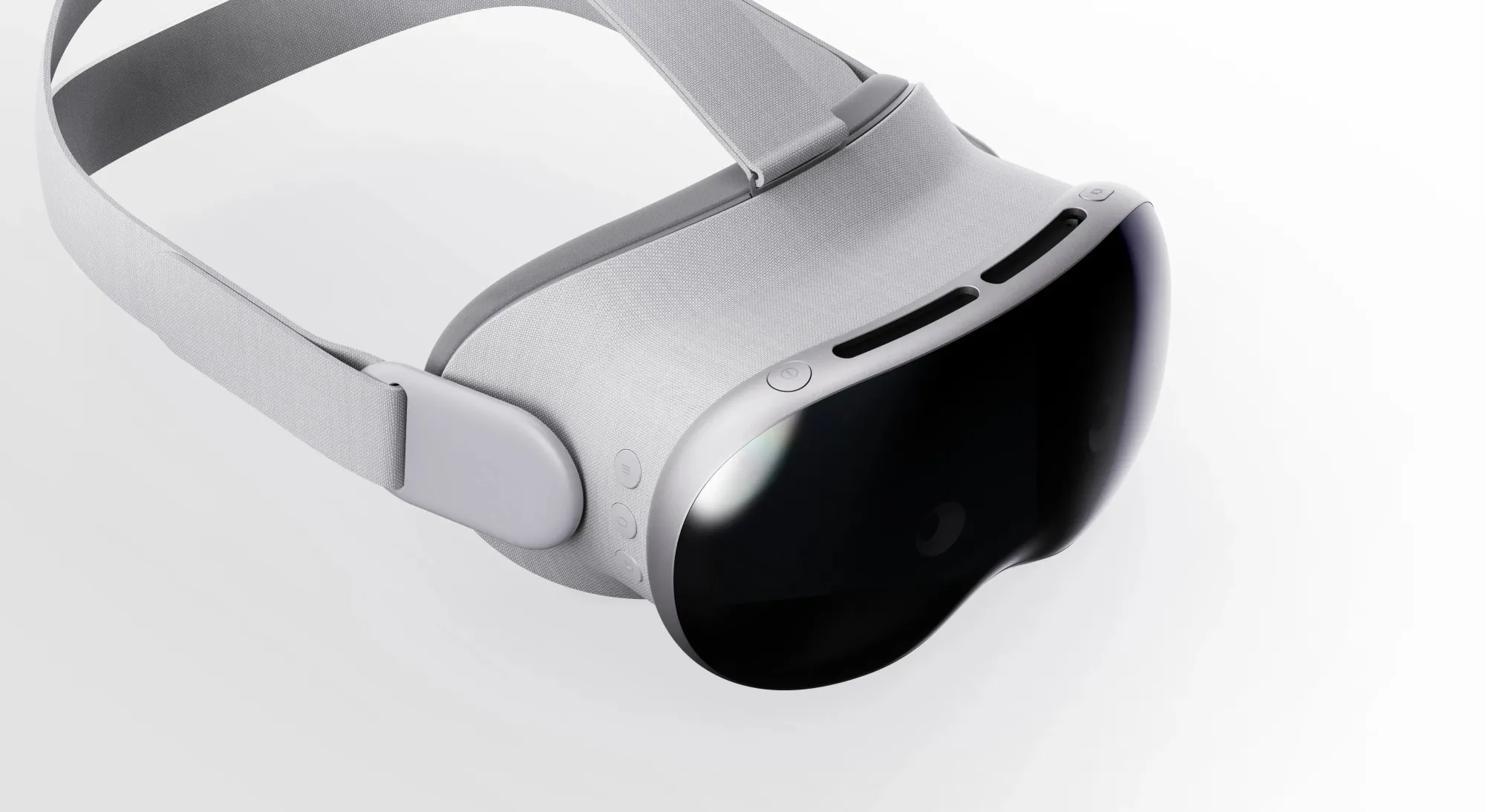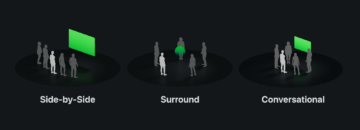There’s already a Chinese knockoff of Apple Vision Pro, and we tried it on at CES.
The AX162 from Chinese startup EmdoorVR is already available to purchase from retailers like Aliexpress for around $500.

It’s clearly designed to resemble Apple Vision Pro as closely as possible, to ride the wave of Vision Pro’s reputation and popularity. But the basic design language is where the similarities end.
UploadVR’s Operations Manager Kyle Riesenbeck tried AX162 by EmDoorVR’s stall at CES 2024 in Las Vegas, and relayed his impressions to me.

AX162 does have color passthrough cameras yes, like Apple Vision Pro, but the quality of the view couldn’t be more different. While my editor Ian Hamilton described Apple Vision Pro’s passthrough as “so good it questions transparent AR optics”, Kyle reports that AX162’s passthrough was low resolution, low framerate, and incorrectly scaled, such that it looked “zoomed in”.
And whereas Vision Pro’s passthrough is shown through pancake lenses paired with dual near-4K OLED microdisplays, AX162 has standard fresnel lenses paired with a single LCD panel to provide less than 1884×1920 per eye, the same resolution as Meta Quest 2.
The use of fresnel lenses also makes it noticeably a thicker headset than Vision Pro, though EmdoorVR tries to hide this by coating part of the frontbox with the same fabric as the facial interface.

The story gets even worse when it comes to the virtual interface overlayed on that passthrough. There’s no 6DoF positional tracking on AX162, so while apps on Vision Pro look like they’re really floating there in your space, even casting shadows, the interface of AX162 is more like what you’d see with media viewer glasses like Xreal Air.
The interface design, as you’d expect, draws heavily from visionOS. You can browse the web, play videos from streaming services or an SD card, and apparently view your phone or PC on a large virtual screen.
But while Apple Vision Pro’s software is powered by the MacBook-tier M2 chipset, AX162 is powered by the lowly Qualcomm Snapdragon XR1. Yes, that’s a 1, not a typo. In the West the Snapdragon XR1 was only used in the HTC Vive Flow. It’s significantly less powerful than the XR2 used in Quest 2. In fact, its GPU is less powerful than even the one in 2018’s Oculus Go. This may not matter much for simple media viewing, but it explains the low passthrough framerate and should make using the web browser feel sluggish.

EmdoorVR told us that AX162 can theoretically support hand tracking, but currently doesn’t because it would be “too heavy” for the chip. Right now it’s controlled by pointing with your head and clicking with a button on the side of the headset. That’s in stark contrast to Vision Pro, where you aim with eye tracking and click by pinching your fingers, an interaction system that those who have tried it described as akin to telekinesis.
So what’s good about the EmdoorVR AX162? Pretty much everyone who wore it, Kyle included, has reported it feeling light and comfortable. Interestingly, the weight and comfort of Apple Vision Pro has reportedly been an issue for testers.
Apple Vision Pro Launches In The US On February 2
Apple Vision Pro will launch in the US on February 2, and preorders open on January 19, next Friday.

The real Apple Vision Pro is set to launch February 2, with preorders opening next Friday, and we suspect EmdoorVR’s AX162 won’t be the last Chinese knockoff of it.
- SEO Powered Content & PR Distribution. Get Amplified Today.
- PlatoData.Network Vertical Generative Ai. Empower Yourself. Access Here.
- PlatoAiStream. Web3 Intelligence. Knowledge Amplified. Access Here.
- PlatoESG. Carbon, CleanTech, Energy, Environment, Solar, Waste Management. Access Here.
- PlatoHealth. Biotech and Clinical Trials Intelligence. Access Here.
- Source: https://www.uploadvr.com/apple-vision-pro-chinese-knockoff/
- :has
- :is
- :not
- :where
- 1
- 19
- 2000
- 2018
- 2024
- 3d
- a
- About
- aim
- already
- also
- an
- and
- Apple
- apps
- AR
- around
- AS
- At
- available
- basic
- BE
- because
- been
- browser
- but
- button
- by
- cameras
- CAN
- card
- casting
- Ces
- cheap
- chinese
- chip
- chipset
- clearly
- click
- closely
- color
- comes
- comfort
- comfortable
- contrast
- controlled
- couldn
- Currently
- described
- Design
- designed
- different
- does
- doesn
- draws
- editor
- end
- Even
- everyone
- expect
- Explains
- eye
- eye tracking
- fabric
- facial
- fact
- February
- feel
- floating
- For
- Friday
- from
- glasses
- Go
- good
- GPU
- Hamilton
- hand
- hand tracking
- Have
- head
- Headset
- heavily
- heavy
- Hide
- his
- HTTPS
- in
- included
- incorrectly
- interaction
- Interface
- IT
- ITS
- January
- jpg
- kyle
- language
- large
- LAS
- Las Vegas
- Last
- launch
- launches
- LCD
- lenses
- less
- light
- like
- Look
- look like
- looked
- Low
- M2
- make
- MAKES
- manager
- Matter
- May..
- me
- Media
- Meta
- Meta Quest
- meta quest 2
- more
- much
- my
- next
- no
- noticeably
- now
- Oculus
- Oculus Go
- of
- Oled
- on
- ONE
- only
- open
- opening
- Operations
- optics
- or
- paired
- pancake
- pancake lenses
- panel
- part
- passthrough
- PC
- per
- phone
- plato
- Plato Data Intelligence
- PlatoData
- Play
- popularity
- possible
- powered
- powerful
- pretty
- Pro
- provide
- purchase
- qualcomm
- qualcomm snapdragon
- quality
- quest
- quest 2
- Questions
- RE
- real
- really
- render
- Reported
- Reports
- reputation
- Resolution
- retailers
- Ride
- right
- s
- same
- Screen
- SD
- see
- Services
- should
- shown
- side
- significantly
- similar
- similarities
- Simple
- single
- sluggish
- snapdragon
- So
- Software
- Space
- standard
- stark
- startup
- Story
- streaming
- streaming services
- such
- support
- system
- T
- testers
- than
- that
- The
- The West
- There.
- they
- this
- though?
- Through
- to
- told
- too
- Tracking
- transparent
- tried
- UploadVR
- us
- use
- used
- using
- VEGAS
- very
- Videos
- View
- viewing
- Virtual
- vision
- vive
- was
- Wave
- we
- web
- web browser
- webp
- weight
- West
- What
- when
- whereas
- while
- WHO
- will
- with
- Won
- worse
- would
- xr2
- yes
- you
- Your
- zephyrnet









